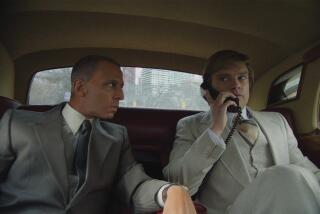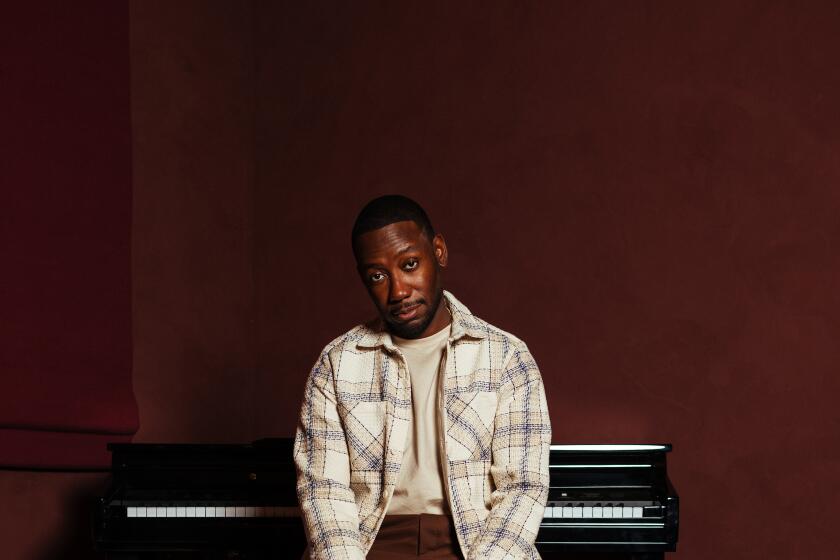Malick deftly navigates a sensual, vast ‘New World’
“THE NEW WORLD” is Terrence Malick’s fourth film in 32 years, basically consolidating his position as the least prolific, most interesting director working today. The movie is both a continuation of his work so far and its culmination, which doesn’t make it any easier to talk about. Words, actually, don’t have much to do with the effect it has on the senses. Like his previous movies -- “Badlands,” “Days of Heaven” and “The Thin Red Line” -- “The New World” doesn’t resist interpretation so much as it wanders away from it in an incandescent brume of wonder, dread and awe. It’s a primal experience about the experience of primacy, if you’ll forgive the fancy tautology.
If you won’t, then you might be frustrated by the movie. There’s bound to be -- there always is -- a range of reaction, just as, no doubt, the movie will be broken down by some into discrete components for greater ease of valuation. This, in my opinion, is a little akin to looking a gift horse in the mouth when you’ve never seen a horse before. Malick is an artist with a singular vision and the skill and support (one hopes) to realize it, and to apply conventional Hollywood standards to his films is to miss their point. He uses sound and imagery to create a vast sensory universe unfiltered through received notions, current politics or moral judgments and historical hindsight. He doesn’t attempt to re-create a period so much as he tries to experience it for the first time, drawing human-scale characters against the enormous and cataclysmic backdrop of nature and history. What we get is not an “objective” or dispassionate view of the world but rather a series of subjective, experiential perspectives. He neither strives for verisimilitude nor spectacle but for an alchemic blend of both -- life in all its power as it is experienced by sentient, sensitive beings.
Captain John Smith (a very good Colin Farrell) travels to Virginia aboard one of three ships financed by the London Virginia Co. along with 102 other men in search of gold. What they find instead is an unspoiled Eden that inspires exalted philosophical reveries about the possibility of forming a new, enlightened society based on justice, equality and shared prosperity. The society Smith envisions, in fact, shares much in common with the society he encounters there, even if not all of the recent arrivals share his view. For their part, the natives’ astonished reaction to the Englishmen who are slowly infiltrating their landscape is laced with concern that has yet to blossom into worry. The scene of their first encounter conveys more wonder and dread than any alien invasion movie could hope for, no matter how impressive its special effects.
The brilliant cinematographer Emmanuel Lubezki captures the grandeur and luminosity of the 1607 Virginia landscape in all its sensual glory, and Malick allows the experience to unfold like a slow dawn. Watching as scenes such as this one convey the strangeness and magnitude of human history and individual experience simply by pausing to observe, it’s hard not to realize how little regard most contemporary films have for both. In all their rushing and jolting and artificial enhancement, most movies reveal a fierce anti-humanist streak, even a contempt for life -- as though time were something to be sped up and wasted. But Malick is an explorer himself, with a talent for expressing the wonder of each new discovery.
The colonists’ initial elation is short-lived, however, as conditions worsen, food becomes scarce and the men struggle to survive. Smith leads an expedition in search of food up the Chickahominy River, and along the way his group is attacked by the Powhatan tribe. His life is spared when Pocahontas (Q’orianka Kilcher), the beautiful and spirited teenage daughter of the chief, intervenes on his behalf, and Powhatan agrees to let him remain and teach the princess his language. Powhatan hopes that this will provide him some insight into the settlers’ intentions. But as Smith acclimates to life among the tribe, he soon finds his ideas about man and society starting to shift and even considers the possibility of staying on to live among them. It’s not just that he’s fallen in love with the princess, who passionately requites his feelings. The civilization of “the naturals,” as the English call them, comes to represent for him the possibility of a new way of being, a rebirth.
If the movie’s dreamlike imagery, shifting inner monologues and sublime score by James Horner are best described as poetic, the movie’s core is thoroughly philosophical. Malick is not interested in ferreting out psychological motivations to explain the movement of history, nor is he interested in passing judgment. Rather, he closely observes the ways in which love, death, war and nature act upon human beings. The story of “The New World” (and for that matter, of the New World) is a fundamentally Hegelian one; initial beliefs lead to their opposite, then to new beliefs that combine but transcend both. Even the love affair between Smith and Pocahontas, sensual and passionate as it is, can be understood in terms of thesis, antithesis and synthesis. For Malick, reality is cognitive, and thus ever-evolving, changing whenever it comes into contact with something new. So, for that matter, is filmmaking. While the version that will be released in New York and L.A. clocks in at 2 hours and 29 minutes, the wide-release version may yet be cut by 20 minutes.When Captain Smith finally returns to Jamestown from his idyllic sojourn among the Powhatan, he finds a lawless settlement turned startlingly feral and primitive by hunger and disease. Powhatan has instructed Smith to tell the settlers to leave, but they have planted corn in his absence, having earlier been given seed by Pocahontas. As they show no sign of departing, Powhatan orders an attack. Pocahontas betrays her tribe by warning Smith, and she is banished by her father and sold to the settlers as insurance against future onslaughts. Among them, she is slowly transformed into an Englishwoman, corseted, heeled and attended by a maid. Smith, meanwhile, is called back to England and tells a friend to tell her he has died. Pocahontas is overcome by grief and retreats into herself.
As the settlement grows, a new arrival, John Rolfe (Christian Bale), takes an interest in her and asks her to help him cultivate tobacco on his farm. Rolfe falls in love with her and asks her to marry him, which the princess agrees to do. She does not immediately love him, however, and the scenes between them are halting and tender. After the birth of her son with Rolfe, Pocahontas learns that Smith is alive, and on a trip to England, where she is received and feted by the king and queen, Rolfe arranges for them to meet. Kilcher, Farrell and Bale are masterful in difficult, nearly nonverbal roles. The courtship scenes of Pocahontas and Smith, lyrical montages that must have been particularly challenging, are profoundly affecting, and Bale likewise is wonderful as the patient, understanding Rolfe, who risks losing his wife to provide her with the chance to choose between them.
The scenes in England are as astonishing as the scenes in Virginia. An ambassador sent by Chief Powhatan to learn more about the English intentions and “meet this God they’re always talking about,” tours the sculptured gardens and topiaries of the royal court, marveling at the symmetrical trees and terraced gardens. Everywhere are straight lines and confined forms. It’s a geometric world, where nature has been conquered and cultivated, representing the inverse and opposite end-point of a civilization, which seen through the eyes of the Powhatan ambassador looks startlingly strange and new. Like the creaky ships slowly shuttling the characters back and forth across the Atlantic, “The New World” is a work of breathtaking imagination, less a movie than a mode of transport, and in every sense a masterpiece.
*
‘The New World’
MPAA rating: PG-13 for some intense battle sequences
Times guidelines: Some violence, but nothing most kids haven’t seen before
A New Line Cinema release. Written and directed by Terrence Malick. Produced by Sarah Green. Director of photography Emmanuel Lubezki. Editors Richard Chew, Hank Corwin, Saar Klein, Mark Yoshikawa. Production design Jack Fisk. Music James Horner. Running time: 2 hours, 29 minutes.
Opens Sunday in limited release.
More to Read
Only good movies
Get the Indie Focus newsletter, Mark Olsen's weekly guide to the world of cinema.
You may occasionally receive promotional content from the Los Angeles Times.










